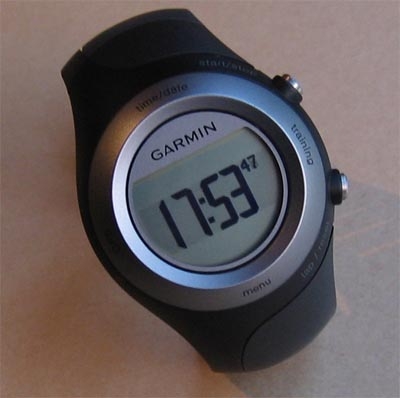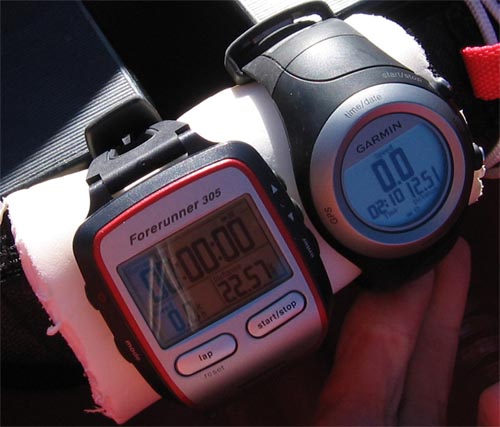Garmin Forerunner 405 – Review
 Garmin Forerunner 405
Credits: www.surfski.info
Garmin Forerunner 405
Credits: www.surfski.info
The latest in the highly popular Garmin Forerunner series is the 405. How does it stack up against its predecessors – from a paddling perspective?
Let me make it clear from the start that I'm a fan of the Garmin Forerunner units. I've used them as training aids, navigation aids and mere logging tools - and I've got the point where I hate to paddle without at least one to tell me my speed and heart rate.
So what's different about the 405?
First Looks
First of all, it's smaller than its predecessors - close to the size and weight of a wristwatch. The screen though smaller, is crisp and the numbers are easy to read.
Next, it has a wireless interface and downloads data automatically as soon as you come within about 5m of your PC.

305 & 405 mounted on surfski footstrap
The most interesting change is the Apple iPod-like touch sensitive bezel. This allowed Garmin to remove all except two buttons on the unit - you touch and tap the bezel to navigate through the menus. This does take a little getting used to though.
Using the 405
I like checking my speed and HR while I'm paddling, so I fastened the 405 to my foot-strap alongside its older brother, my venerable 305. The 405's wrist strap is more rigid than the 305's so I used a piece of rubber to thicken the foot-strap for the two units as shown below.
I have to say that I found the unit quite finicky to use. For example, with the 305, it's a case of:
-
Switch on.
-
Wait for the satellite connection.
-
Press Start.
With the 405 I have to
-
Unlock the bezel,
-
Bring up the GPS menu by touching the left hand side of the bezel.
-
Stroke down to GPS.
-
Tap to switch the GPS on
-
Touch the right hand side of the bezel (without inadvertently switching the GPS off again) to open the training menu,
-
Lock the bezel,
-
Wait for satellite connection
-
Press Start
The bezel is sensitive to the slightest touch - as I found when water drops caused the screen to change unexpectedly. One of the most important discoveries was how to lock the bezel.
Battery Life
The unit specs say that the battery should last up to two weeks in "power save" mode; in training mode it'll last about eight hours. What this means is that you need to switch the GPS off as soon as you come off the water and you to be aware of the battery charge at all times - you don't want to start a three hour paddle with the unit on 25% battery!
Training with the 405
The 405 has much the same functionality as the previous Forerunner units including simple, interval and custom workouts where you can specify effort (measured by heart rate) and interval times.
Navigating with the 405
A screen I really like on the 305 is the navigation page. It displays a compass and, importantly, the distance and time remaining to your destination. In Hawaii, that "distance remaining" indication was all that kept me going!

Navigation - 305 (left), 405 (right) and the venerable 301 (bottom)
The 405 has minimal navigation capabilities: you can mark and edit locations and you can Goto a location. You can also go "Back to Start" but you can't create a route and the navigation page shows only the compass and distance; not the time remaining.
What I like about the 405
-
The size: it's much more comfortable to wear than the earlier models and looks like a watch.
-
The GPS sensitivity: it picks up the satellites quicker and stays locked on better than any previous unit.
-
The wireless interface to the PC
What I don't like
-
The short (8 hour) battery life in training mode.
-
The bezel doesn't work well if your hands are wet with salt water.
-
The finicky user interface.
Summary
Runners will probably prefer the Forerunner 405 but, from a paddler's perspective, I prefer to have:
-
A bigger display: My 305 is configured to show speed, distance and time (and if I'm training, speed, heart rate and time). The smaller figures on the 405 are difficult to read especially when it's mounted on my foot-strap.
-
More battery time: The 305 does around 14 hours.
-
More navigation functionality: the 305 allows you to create a route comprising several waypoints and it shows you the time remaining to reach your destination.
-
The ability to control the unit via the buttons - even at sea. With the 305 I can change the screens and even the mode (from training to navigation) by pressing the buttons. I found the touch-sensitive bezel of the 405 almost impossible to use with wet hands - so once you've set the unit up, it's really difficult to change it.
This is a cool and undoubtedly more advanced piece of technology - and Multisport athletes will love it - but in my opinion the 305 is still the best choice for paddlers.

